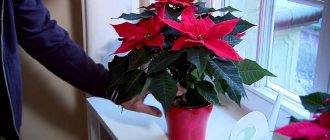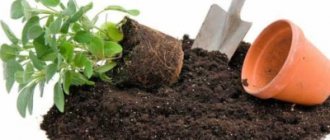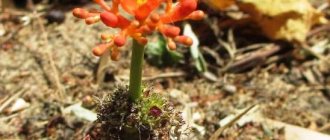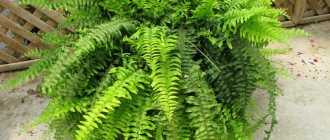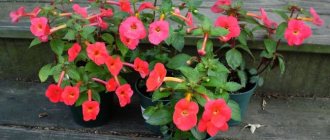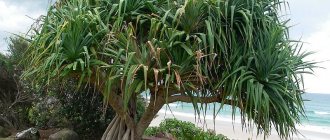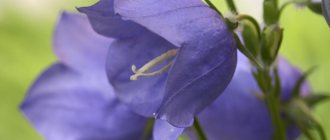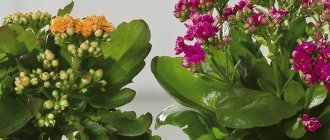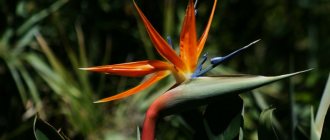Poinsettia (poinsettia) is an amazingly beautiful indoor plant that has captivated flower growers with its unusual bracts of bright colors, similar to stars. Blooms in winter, on New Year's holidays and Christmas. Blooming poinsettia is still an exotic, but very stylish addition to the traditional Christmas tree, garlands and gift wrappings in Russia. In Europe, the plant is most often thrown away after the holidays, not wanting to spend time and effort throughout the year trying to make it bloom again. But if you know the simple rules for caring for poinsettia at home and follow them exactly, the flower will delight you for many years.
Description of poinsettia
Poinsettia (sometimes in Russian-language sources there is a variant spelling with one “t” - poinsettia) is a species of herbaceous or bushy plants belonging to the Euphorbiaceae family and numbering more than 100 representatives.
In Europe, poinsettia is known as “the most beautiful spurge” (Euphorbia pulcherrima - the official name according to the botanical classification), “Christmas” or “Star of Bethlehem”. This is due to the timing of flowering - beautiful bracts bloom just on Catholic Christmas.
In nature, poinsettia looks quite impressive, but “indoor” specimens are significantly smaller
In nature, poinsettia is found exclusively in the tropics. She feels great in the shade of taller trees, preferring mountain slopes. Its habitat is Central America (Mexico, Costa Rica, Guatemala, Belize).
Under natural conditions, poinsettia is a low, graceful shrub 1–3 m high. “Home” poinsettia rarely grows above 0.5 m. The average height of the bush is 30–35 cm. The stems branch intensively, the branches are bare below. The leaves are rich green in color, usually smooth to the touch, in the shape of an elongated ellipse, pointed at the end. The edges are serrated. The average leaf length is 12–15 cm, width is about half that.
Poinsettia leaves surrounding the inflorescences change color
Contrary to popular belief, poinsettia flowers are very inconspicuous. They are very small, yellowish, collected in inflorescences in the shape of an umbrella or rosette. What are considered bright petals - scarlet, crimson, snow-white, combined - are actually bracts. They are densely located on the tops of the shoots. Poinsettia forms buds in mid-December; bracts last until the end of winter.
What is often mistaken for flower petals in poinsettias are actually bracts
Like all Euphorbiaceae, poinsettia stems and leaves contain milky white sap. It is quite caustic and can severely burn sensitive skin, so all work with the plant should be carried out only with rubber gloves. In case of contact with the mucous membrane, there is a risk of severe nausea, vomiting, and stomach pain. Anyone who is allergic to plant pollen should be careful with the flower. Since angioedema and anaphylactic shock can develop.
However, the American aborigines learned to “squeeze lemonade out of lemons.” After certain processing, they use the poisonous juice as an effective antipyretic, a drug for toothache, and a remedy for warts and insect bites. Poultices from the leaves help relieve attacks of rheumatism and radiculitis.
The world owes the popularization of the plant, which was known to the Aztecs under the unpronounceable name cuetlaxochitl (the Indians perceived it as a symbol of beauty), to the first US Ambassador to Mexico, and part-time physician and amateur botanist, Joel Roberts Poinsett (or, in the French manner, Poinsett) . It was in honor of him that the flower received its name.
In Europe and the USA, Christmas without poinsettia is unthinkable, just like without a spruce tree and gifts.
The fashion of giving poinsettias for Christmas at the beginning of the 20th century was introduced by the owner of the greenhouse, Albert Ecke, and consolidated by his son Paul.
Poinsettia is also valued among adherents of the teachings of Feng Shui. It is believed that the flower develops the owner’s sociability, attracts pleasant people to his home, neutralizes the influence of negative energy, “extinguishes” conflicts and quarrels, and relieves stress. The owner of the poinsettia develops leadership qualities, women lose weight effortlessly and look significantly younger than their age. Because of such “violent activity”, it is not recommended to place the flower in the bedroom - it simply will not allow the owner to sleep peacefully.
Video: appearance of the most beautiful poinsettia
Types of plants popular among amateur gardeners
“Natural” poinsettias, despite their abundance, are almost never found among gardeners. Their place is taken by selectively bred hybrids. Most often, plants are classified according to the shade of their bracts:
Red poinsettias are a classic option. A combination of red and bright green (same as the holly wreaths).
Photo gallery: red poinsettias
Angelica - classic red bracts, effectively contrasting with dark green leaves, the shade is bright, but not flashy (other varieties with bracts of the same tone - Sonora, Premium Red, Galactica, Prestige Maroon)
The Olympia variety has pale red bracts that are velvety to the touch, although the leaves themselves are smooth
The Cortez Fire hybrid has bracts that resemble flames, shimmering in shades of red-orange, Peterstar is very similar to it
The “trick” of the Red Diamond (and Freedom) variety is a very pure scarlet color
The hybrid Carousel Dark Red has corrugated bracts along the edges (this is a distinctive feature of the entire group of Carousel varieties)
From a distance, the blooming Winter Rose poinsettia can easily be confused with an old English rose variety - the bracts are round, with slightly turned-back edges
The Champion variety is distinguished by its unusual pale red bracts.
Jester Red poinsettia has bracts the color of fresh blood covered with veins of a darker, burgundy hue.
The Dark Red variety and the similar Freedom Coral have very dark bracts, almost like those of Baccarat roses.
The Harlequin Red variety is distinguished by the shape of its bracts - they are strongly corrugated parallel to the central vein, sharply pointed
Pink poinsettias have colors ranging from soft pastels to crimson and bright neon shades.
Photo gallery: pink plant varieties
Variety Maren, Pink Ribbon and some others - classic pink color
Poinsettia Freedom Pink - a very delicate, creamy pink shade
Hybrid Cortez Pink - unusual peach or salmon tone, depending on growing conditions
Variety Pink Ell very bright crimson bracts
Monet Twilight and similar Da Vinci - light and dark shades smoothly flow into each other, pinkish bracts seem to be sprinkled with flour
The Annette Hegg poinsetti has dark crimson bracts.
White poinsettias are not very popular compared to others, but no less impressive. They are even more elegant and graceful.
Photo gallery: white poinsettias
The Regina variety is characterized by the presence of clearly visible lettuce veins on a white background
Silverstar White - pure snow-white color of the bracts
Whitestar - white has a slight green tint
In the Freedom White hybrid (as well as Polar Bear, Infinity White), the bracts are silvery in artificial light
Cortez White and similar Sonora White - an unusual shade of ivory, slightly shimmering with mother-of-pearl
Varieties of poinsettias
Experts have developed several types of Christmas stars; they differ in the color of the bracts and the shape of the leaves.
Here are the most common varieties:
The classic look is recognizable by the bright red color of the tops. Such flowers are popular in Europe, including Poitnessia Eckespoint Freedom Red and Mars.
Freedom with red tops
A sophisticated variety, whose popularity is constantly growing in Russia, with light tops. The bracts are white or light yellow, the leaf size is large, and the surface is glossy. The most striking representatives of light poinsettias are Cortez White, Enduring White, Whitestar, Regina.
Blooming Cortez White
The varieties Amazon Peppermint, Strawberry and cream, Silverstar Marble, and Peterstar have pink bracts. Their color intensity differs; Peterstar has the brightest tops.
Pink Peterstar in active flowering stage
Variegated varieties Silverstar Marble, Sonora, Sonora White, Monet Twilight, Marblestar, Jingle Bells Sonora have multi-colored bracts. The veins can be white, light yellow, light green. The varieties are highly decorative.
Blooming Sonora with light yellow splashes
How to create an optimal microclimate for a plant
Poinsettia comes from the tropics, but it does not like heat and bright sunlight, preferring in natural conditions to hide under the shade of taller trees with closely intertwined crowns.
A poinsettia standing on a windowsill in the cold season should not touch the glass even with one of its leaves. The plant reacts sharply negatively to temperature changes, especially in combination with cold drafts.
Table: recommended conditions for growing poinsettia at home
| Factor | Recommendations |
| Location | Not far from a window facing east or west. If there is artificial additional lighting, northern windows are also suitable. The poinsettia that is about to bloom is moved closer to the south window. In warm weather, the flower feels good outdoors if it is protected from precipitation, gusts of wind, and the scorching sun. In summer it should be possible to regularly ventilate the room. |
| Lighting | The light is bright, daylight hours in summer are 12 hours or more, protection from direct sunlight is necessary. In cloudy weather you will need special phytolamps. |
| Temperature | Most of the year - 20–25ºС. During flowering - a little lower, but not less than 15ºС. During the rest period - 13–15ºС. Below 12ºС is critical for a flower; it may fall asleep and not wake up. |
| Air humidity | The minimum indicator is 60%. Move the flower away from radiators, spray the poinsettia and the surrounding air at least once a day (2-3 if possible). Place a special humidifier device, containers with water, wet moss, expanded clay, and peat nearby. |
How to trim and replant a flower
Replanting poinsettias of any age is an annual procedure, since the flower grows quite quickly. In early spring, about a third of the length of each shoot of a faded plant is cut off, leaving 3–5 growth buds. Place the flower in a warm place and provide sufficient watering. Poinsettias can be replanted when new leaves appear. This usually occurs in April or May.
Immediately before transplanting, poinsettia looks like this
Preparing the soil, choosing the optimal pot
A very large pot of poinsettia is not needed. Preference is given to a container 2–3 cm larger in diameter than the previous one, with a large drainage hole, made of unglazed ceramics. Air penetrates into the pot through the pores, and aeration (ventilation) of the roots is an effective way to prevent rot.
When choosing a pot for poinsettia, give preference to a simple ceramic container.
The flower prefers a slightly acidic substrate (pH - about 6). A special soil for Euphorbiaceae is suitable. If you couldn’t buy one, it’s easy to mix the soil yourself:
- dense clay turf, leaf soil, peat chips, coarse river sand (3:2:1:1);
- universal soil for flowering indoor plants, powdered dry manure, sand (2:1:1);
- leaf humus, peat, perlite or vermiculite (3:2:2).
Transplant procedure
- Provide the flower with good drainage by pouring a layer of expanded clay or material with similar properties at least 3 cm thick on the bottom of the new pot.
- Fill about a third of the pot's volume with fresh substrate.
- Half an hour before the procedure, water the flower and remove it from the old container. If that doesn't work, gently tap the sides of the pot. Try to keep the earthen ball undestroyed.
- Inspect the roots as much as possible. Trim off any dry or damaged ones, especially those blackened by rot. Sprinkle the sections with sifted wood ash, activated carbon powder, colloidal sulfur, and powder with Kornevin.
- Place the flower in a new container, add substrate around the edges. To ensure even distribution, shake the pot several times. It is not advisable to compact the soil with your hands.
- Place the transplanted poinsettia in a warm place (20ºC or slightly higher), water it generously, and spray it daily.
- After new shoots appear, leave 5–6 of the strongest and best located ones, cut the rest as close to the ground as possible, without leaving “stumps”.
- Move the poinsettia to its old location and care for it as usual.
When should you replant store-bought flowers?
Many sellers recommend not replanting potted flowers until the end of flowering, but often in a small pot the roots of the flower are already tightly entwined with a small volume of peat and have practically no substrate and nutrition, and therefore no strength for lush flowering, so it is better to replant using the transshipment method as early as possible...
Interesting materials:
How to translate phone into English? How to translate your phone into Russian for iPhone? How to put your phone into fastboot mode? How to put your phone into download mode? How to switch your phone to touch tone? How to switch your phone to iPhone tone mode? How to change the time on a Samsung phone? How to reboot the camera on a Samsung phone? How to reboot a Samsung feature phone? How to reboot a feature phone?
How to properly care for a plant
Watering
During active growth, poinsettia is watered thoroughly every 2-3 days. The substrate should dry completely at a depth of 1–1.5 cm . Focus on the weather outside, the temperature and humidity in the room - both flooding and overdrying the soil are equally harmful for a flower.
Water for watering and spraying poinsettias should be soft. If it is not possible to use rain or melt water, leave the water supply for at least a day. To soften, throw a little citric acid into the container (a few crystals are enough for 10 liters) and wait for a white-gray precipitate to form in the form of flakes. The optimal temperature is about 30ºС.
Fertilizer application
Fertilizing stimulates flowering. After transplantation and before the beginning of autumn, poinsettia is watered with a solution of complex liquid mineral fertilizer every 12–15 days.
Poinsettias can also use universal fertilizers, but it is better to find a product for Euphorbiaceae or at least for cacti and succulents
Or, when replanting, you can add slowly dissolving granules to the soil. If you cannot find a special product for Euphorbiaceae, any fertilizer for flowering indoor plants or fertilizer for cacti and succulents will do.
Rest period
The plant needs an annual rest after flowering. The rest period lasts 7–8 weeks. When the bracts are completely dry, cut them off and put the pot in a cool, dark (13–15ºС) room.
Before the dormant period, poinsettia looks something like this; dry leaves must be trimmed, fallen leaves must be removed from the pot.
A resting flower does not need feeding. During this period, reduce watering - it is enough to moisten the soil once a week. The soil should be almost completely dry.
Some gardeners recommend cutting the plant right away, leaving about a third of the length of the shoots, but this can be done in the spring, just before replanting.
How to make poinsettia bloom for the New Year holidays?
In order for poinsettia to bloom again, you need to follow certain recommendations. This way the plant will delight you for 8–10 years. It is better not to disturb young poinsettias grown from cuttings this spring - most likely they will not bloom.
- Starting from the end of September, cover the flower every day with a thick, dark-colored plastic bag, bucket, or box, as soon as it starts to get dark outside. Or put it in a room without windows, in a closet with well-fitting doors (in the absence of complete darkness, the bracts will become covered with ugly dark spots). If the climate allows, place the flower in a greenhouse without lighting or heating or in the garden. The natural cycle of day and night is best for him.
- In the morning (around 9:00) return the pot to its original place. The plant should spend at least 12 hours in complete darkness (preferably 14). Reduce watering slightly.
- After 8 weeks, leave the flower alone. If everything is done correctly, it will begin to intensively increase green mass.
- After another 15–20 days, flower buds will appear. Place the plant near a south-facing window. The bracts bloom quite quickly if you regularly spray the buds with warm water.
A blooming poinsettia next to the Christmas tree looks somewhat unusual
Fruit dishes, especially apples, pears and bananas, should not be placed next to blooming poinsettias. They emit ethylene, which causes the bracts to wilt very quickly.
There is a sign: if you manage to get poinsettia to bloom for the holidays, good luck will definitely smile on you in the coming year.
What to do after buying a poinsettia
So, the purchase is made and you, satisfied, bring the poinsettia home. What to do next?
First, choose a well-lit window sill for her. Keep in mind, it does not tolerate drafts ! While the poinsettia is acclimatizing, create a room temperature for it at 16-17 degrees.
The habituation process will last her about three weeks. After this, transplant it into the ground, having first made good drainage, adding sand and vermiculite.
This video shows how to care for the plant after purchase, how to prune it and how to make it bloom next year:
Typical flower diseases and pests
The pungent sap of poinsettias repels many pests, but some are not deterred. And because of the gardener’s mistakes, dangerous diseases can develop.
Table: what diseases and pests does poinsettia suffer from?
| Disease or pest | How does it manifest itself externally? | Struggle | Prevention |
| Mealybug | A whitish coating, similar to dirty cotton wool, at the base of the shoots, on the petioles, on the underside of the leaf blade, leaves sticky to the touch; deformed shoots and flower buds. In especially severe cases, the plant seems to be sprinkled with flour. |
|
|
| Spider mite | Thin, almost imperceptible threads entwining petioles, bracts and curled dried leaves, rapidly increasing discolored, translucent areas on the leaf plate. In case of massive damage, clusters of pests appear at the tips of the leaves - the movement of this mass is visible. |
|
|
| Whitefly | Small whitish insects, similar to moths, fly over the flower; it is enough to lightly touch it. The leaves curl, become deformed, turn black, and the stems become thinner. |
|
|
| Thrips | Colonies of small black-brown insects, similar to flatworms with legs, settle on the underside of the leaf. It takes on an unnatural silvery-white hue, and thin “scratches” and small beige dots are also noticeable. The stems become deformed and the leaves dry out. |
|
|
| Gray rot | Grayish-white spots appear on the leaves, then become covered with long gray “lint” with small black dots inside. The fungus spreads quickly, the plant dries out sharply and dies. Individual parts turn black and fall off. |
|
|
| Fusarium | Discolored “watery” areas on losing tone, drooping leaves, a dark “mesh” in the leaf tissues, clearly visible in the light, and a black ring on the cut of the shoot. The affected plant dries quickly and the above-ground part dies. |
|
|
How does the plant propagate: by seeds or cuttings?
Growing poinsettia from seeds is a rather lengthy and troublesome process. In addition, seedlings rarely retain the varietal characteristics of the mother plant. Therefore, this method is of interest mainly to professional breeders.
Reproduction by cuttings
The easiest way to propagate poinsettia is to root a cutting. There will be no problems with planting material, because every year the plant undergoes radical pruning. Flowering can be expected next winter - approximately 1.5 years after planting.
Cuttings are taken only from completely healthy poinsettias. The recommended length is 12–15 cm (there must be at least 5 internodes).
- Cut the cutting at a slight angle. The knife must be disinfected and sharpened.
- Blot the juice released from the cut with a soft napkin. If its flow does not stop, immerse the cutting in cool water for 10–15 minutes.
- Sprinkle the cut with sifted wood ash, powdered activated carbon, colloidal sulfur, and powder with Kornevin.
- Plant the cuttings in containers filled with a mixture of peat chips, humus, crushed manure and sand, perlite, vermiculite (1:1), moistening the substrate well.
- Cover the pots with glass jars or cut-off plastic bottles and place them in plastic bags. Open the “greenhouses” every day for 5–7 minutes to ventilate, and as the substrate dries, water it moderately with a weak solution of any root formation stimulator.
The following conditions will have a positive effect: a constant temperature of 25–28ºС, bright diffused light and lower heating.
Growing poinsettia from cuttings is a simple task that even a novice gardener can handle.
- Under optimal conditions, cuttings produce roots in 25–30 days. Transplant them into slightly larger containers with a substrate for adult plants and cut them back by about a quarter so that the poinsettia begins to “tush”. Further care is the same as for adult flowers.
Resuscitation methods
Growing poinsettias is not difficult. Creating comfortable conditions will help to avoid problems, and the plant will delight the eye with unusual leaves.
Note! The flower reacts to polluted air, for example, tobacco smoke, fumes from food during cooking. Therefore, you need to keep the plant indoors where there is constant access to fresh air. It is important to avoid drafts.
You need to carefully monitor watering. If the leaves are curled and the soil is too dry, water the flower generously. Then he will regain his healthy appearance. The lower leaves may still fall off. Spraying will moisten the plant and eliminate the appearance of spider mites.
All damaged leaves must be removed so that the flower does not waste energy on them, but gives it to new shoots. Timely replanting and pruning will help preserve the blooming appearance.
Blooming poinsettia
The Christmas flower poinsettia is popular among gardeners. This is a wonderful Christmas gift that will fill your home with bright colors. The unusual leaves will delight you all winter long when other plants are dormant.
